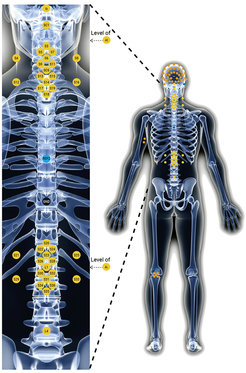Non-invasive method measures finest reactions of the spinal cord
Scientists at the Max Planck Institute for Human Cognitive and Brain Sciences in Leipzig (MPI CBS) have developed a novel, non-invasive method to record electrical activity in the human spinal cord with high precision and sensitivity. The reactions of the spinal cord to pain stimuli can also be measured more accurately, which could open up new avenues for pain research and potential clinical applications. The study was recently published in the journal PLOS Biology.
"Together with the simultaneous recording of responses from peripheral nerves, the brainstem and the cortex, our multi-channel spinal cord electrophysiology method provides the missing building block for a comprehensive view of somatosensory processing along the entire neuronal processing pathway," explains first author Birgit Nierula. "In addition to the methodological advances, our study has shown that the integration of sensory information takes place not only in the brain, but also at the level of the spinal cord, which calls into question the long-held view that the human spinal cord is a simple relay station."

Up to 40 electrodes were attached to the study participants' backs, allowing the researchers to receive even finest signals that cannot be measured using conventional methods. Vadim Nikulin, who heads the 'Neuronal Interactions and Dynamics' research group and was in charge of developing the new method, describes the background: "In humans, electrophysiological research on the somatosensory system has mainly focused on cortical structures due to methodological limitations. However, one crucial question remained: Do the complex spatiotemporal dynamics of cortical somatosensory responses actually reflect subcortical and spinal cord processes? With our current methodological advances, we have created an unprecedented opportunity to pursue answers in a single experiment already at the level of the spinal cord. This paves the way for obtaining critical control measures that allow accurate conclusions about the origin, modulation and interaction of somatosensory responses across different brain structures."
Falk Eippert, last author of the study together with Vadim Nikulin and head of the 'Pain Perception' research group at the MPI CBS, adds: "We can see in the millisecond range when a signal arrives in the spinal cord. In terms of researching pain and how it arises, such a highly precise method is extremely helpful." To test this, the team used a laser beam to generate heat pain in the study participants, for example, and then measured the signals in the spinal cord. "In the future, our method could also become relevant for clinical research, for example in the development of medication in the context of chronic pain," says Eippert, giving an outlook.












